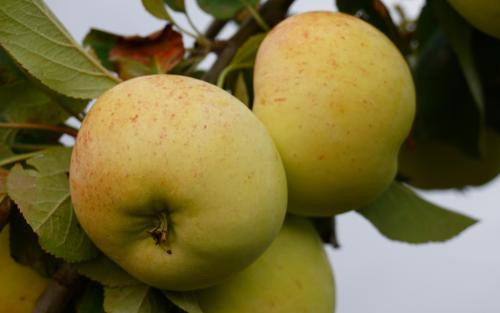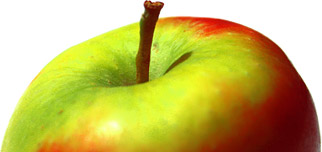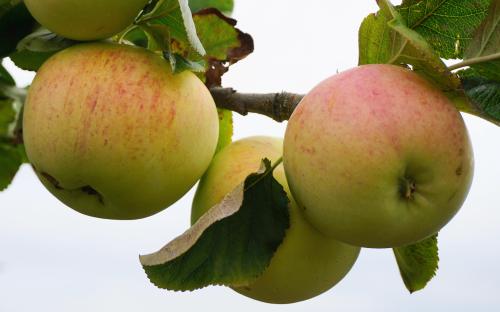Reverend W Wilks apple

Reverend W. Wilks is an early-season culinary apple variety, raised at Langley Nurseries in the early 20th century. Reflecting the great importance attached to cooking apples in England at that time, it was named after the then secretary of the Royal Horticultural Society.
Reverend W. Wilks has many of the hallmarks of the English cooking apples of the previous Victorian era - it is a large, juicy, acidic apple. Like many similar varieties it is also very easy to grow and the tree is resistant to all the common apple diseases and suitable for most temperate climates.
It remains a popular variety throughout the United Kingdom to this day, being versatile in the kitchen and coming into season towards the end of August before the main late-season cookers are available.
Reverend W Wilks apple identification images
All images copyright Orange Pippin unless otherwise stated.
USDA identification images for Reverend W Wilks
The identification paintings in the USDA Pomological Watercolor Collection span the years 1886 to 1942.
Citation: U.S. Department of Agriculture Pomological Watercolor Collection. Rare and Special Collections, National Agricultural Library, Beltsville, MD 20705.
Parents and other ancestors of this variety
- Peasgood's Nonsuch (parent)
- Ribston Pippin (parent) - Ribston Pippin is probably a parent of Reverend W. Wilks.
Visitor reviews
- 10 Jul 2014 Andrew ParryWORCESTERSHIRE, United KingdomA person I know has just had her apple tree identified as Rev W Wilks (exact DNA profile) by the East Malling Research institute. The apples off her tree turn to pale yellowy green by October and have the most amazing delicate flavour. Not bitter at all. Very crisp and juicy
- 29 Aug 2013 Steve DibbleDERBYSHIRE, United KingdomIve had this tree for last 20 years and it produces an abundance of fruit every 2 years with small crop in intervening years. Very tasty cooker going to smooth puree when cooked. Average fruit size 75mm. Does not keep long though, and best stored in cool dark environment with plenty of air circulation. Crops around early to mid september keeps to around christmas / early January if theres any left by then. Needs very little sugar when cooking. You will have friends and neighbours queing up for them.
- 16 Jan 2011 h O'BrienSURREY, United KingdomThe variety has a tendancy to biennial bearing. Otherwise very productive.
- 13 Sep 2010 N. BuckCAMBRIDGESHIRE, United KingdomFruits are large, pale milky green colour. Flavour is good and fruits have a very pleasing scent, but the scent is misleading as the fruits are much too bitter to be suitable for eating raw. Good disease resistance. Compact, tidy and easy-to-grow tree. Not much troubled by maggots, but, like Grenadier, it suffers from superficial nibblings of capsid bugs and earwigs. These can be peeled off while preparing for cooking.
Tree register
United Kingdom
- Biggsy50 in Hitchin, HERTFORDSHIRE
- Billy Auger in Hopton Wafers, SHROPSHIRE
- Bob Henley in Winchester, HAMPSHIRE
- Deborah Kaufmann in Ashton Under Lyne,
- Douglas Silverstone in Chesham, BUCKS
- Douglas Silverstone in Chesham, BUCKS
- Graeme Stockdale in Pilsley, Chesterfield, DERBYSHIRE
- Graham Hinchliffe in Eastbourne, EAST SUSSEX
- Jean Lippett in Martock, SOMERSET
- John Nutt in Aston, HERTFORDSHIRE
- Kevinincornwall in Liskeard, UNITED KINGDOM
- Margaret Brooker in Ellerker, EAST YORKSHIRE
- Mark in Chippenham, WILTS
- Mark Brisbane in Winchester, HAMPSHIRE
- N. Buck in Cambridge, CAMBRIDGESHIRE
- Neil Smith in KIPPEN, STIRLING
- Peter Revell in Hemel Hempstead, HERTS
- Philip in
- Richard Jones in Liskeard, CORNWALL
- Ross in Blaenau Ffestiniog, GWYNEDD
- Sue Morris in Maidstone, KENT
- Tamas Geleta in UCKFIELD,
- Terry Smith in Huntingford, DORSET
- Twittykins in Hucknall, NOTTINGHAMSHIRE
Norway
- Henrik Melsom Edvardsen in STAVANGER,
Spring blossom records for this variety
2013 season
- 10th May 2013 - tree owned by Jean in Martock, United Kingdom
2010 season
- 28th April 2010 - tree owned by N. in Cambridge, United Kingdom
2009 season
- 20th April 2009 - tree owned by N. in Cambridge, United Kingdom
Record your blossom dates in our Fruit Tree Register - more >>.
Harvest records for this variety
Origins
- Species: Malus domestica - Apple
- Parentage: Probably Ribston Pippin and Peasgood Nonsuch
- Originates from: Berkshire, England, United Kingdom
- Introduced: 1904
- Developed by: Veitch, Chelsea, London.
- UK National Fruit Collection accession: 1979-183
- Some historical details taken with kind permission from 'The New Book of Apples' by Joan Morgan and Alison Richards , illustrated by Elisabeth Dowle, published by Ebury Press, 2002.
Identification
- Country of origin: United Kingdom
- Period of origin: 1900 - 1949
- Flower colour: White
- Leaf colour: Green
- Annual cycle: Deciduous
Using
- Picking season: Early
- Keeping (of fruit): 2-3 weeks
- Flavour quality: Good
- Flavour style (apples): Sweet/Sharp
- Cooking result: Puree
- Discoloration of fruit: Very oxidising (browns quickly)
- Cropping: Good
- Food uses: Culinary
- Food uses: Traditional cooker
- Wildlife: RHS Plants for Pollinators
Growing
- Gardening skill: Beginner
- Flowering group: 2
- Pollinating others: Average
- Ploidy: Diploid
- Vigour: Slightly small
- Precocity: Precocious
- Bearing regularity: Biennial tendency
- Fruit bearing: Spur-bearer
- Organic culture: Suitable
- Self-fertility: Self-fertile
Climate
- Climate suitability: Mild damp climates
- Summer average maximum temperatures: Cool ( 20-24C / 68-75F)
- Summer average maximum temperatures: Cold (< 20C / 67F)
Other qualities
- Disease resistance: Good
- Canker: Some resistance
- Scab (Apple and Pear): Some resistance
- Powdery mildew: Some resistance
Where to buy trees
The following tree nurseries offer Reverend W Wilks apple trees for sale:
- Orange Pippin Fruit Trees (UK) United Kingdom
Reverend W. Wilks apple trees
Where to buy fresh fruit
The following orchards grow Reverend W Wilks:
United Kingdom
England - midlands
References
- Apples of England (1948)
Author: Taylor - Fruit Expert
Author: Hessayon


